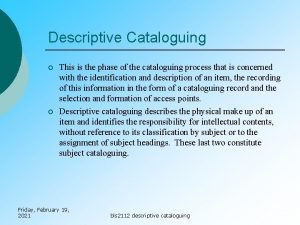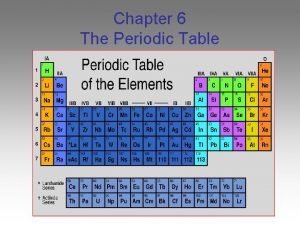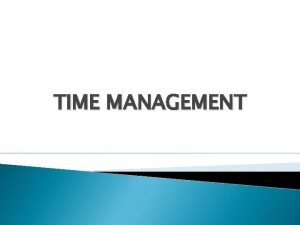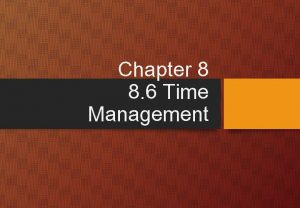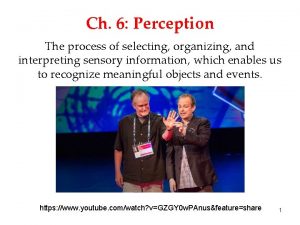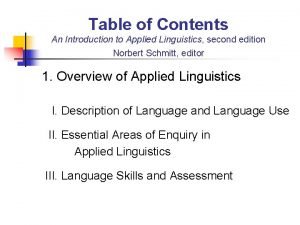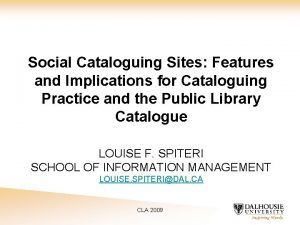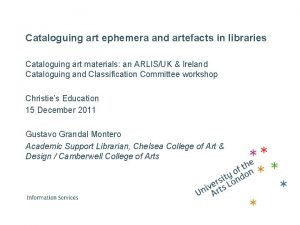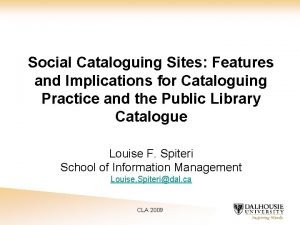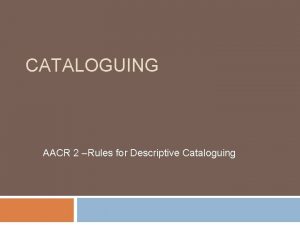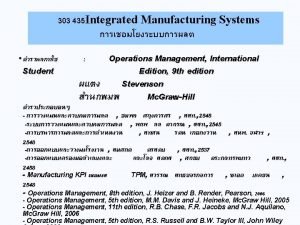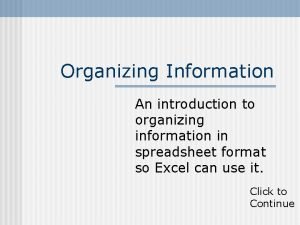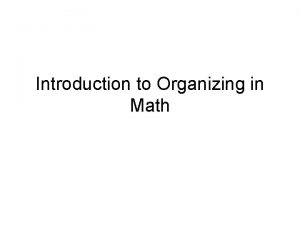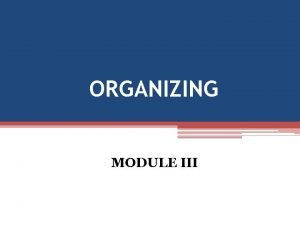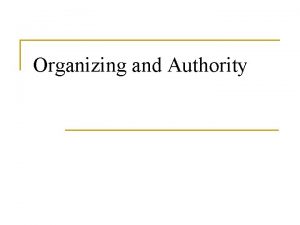Applied Cataloguing Introduction Cataloguing The process of organizing




![Second Level of Description � Title proper [general material designation] = Parallel title : Second Level of Description � Title proper [general material designation] = Parallel title :](https://slidetodoc.com/presentation_image_h2/d41f19fcd5096ab0bc2f8f93213bee65/image-5.jpg)











- Slides: 16

Applied Cataloguing

Introduction � Cataloguing - The process of organizing library materials and making them accessible to library users. Cataloguing work is divided into three parts: descriptive cataloguing, subject cataloguing and classification � Applied cataloguing is the process that reference the application of theoretical aspects for the recording of Bibliographical information. � Cataloguing is the process of making library catalogues. � Managing bibliographical information by using set rules for uniformity

Description of Materials 2. 3. 4. 5. 6. 7. 8. 9. 10. 11. 12. Books, Pamphlets, and Printed Sheets Cartographic Materials Manuscripts (including Manuscript Collections) Music Sound Recordings Motion Pictures and Videorecordings Graphic Materials Computer Files Three-Dimensional Artifacts and Realia Microforms Serials

Level of description � There are three levels of description in the catalogue: Author Main Entry (Author Name) Title proper / first statement of responsibility. -- Edition statement. -- Material (or type of publication) specific details. -- First place of publication : first publisher, date of Description of Materials publication Extent of item : other physical details ; dimensions. – (Title proper of series) Note(s) Standard number and Terms of availability
![Second Level of Description Title proper general material designation Parallel title Second Level of Description � Title proper [general material designation] = Parallel title :](https://slidetodoc.com/presentation_image_h2/d41f19fcd5096ab0bc2f8f93213bee65/image-5.jpg)
Second Level of Description � Title proper [general material designation] = Parallel title : other title information / first statement of responsibility ; each subsequent statement of responsibility. -- Edition statement / first statement of responsibility relating to the edition. -- Material (or type of publication) specific details. -- First place of publication, etc. : first publisher, etc. , date of publication, etc. -- Extent of item : other physical details ; dimensions. – (Title proper of series/ statement of responsibility relating to series, ISSN of series ; numbering within the series. Title of subseries, ISSN of subseries ; numbering within subseries). -- Note(s). -Standard number

Areas of catalogue � Title statement � Statement of responsibility � Edition statement � Imprint area(place, publication and year) � Physical description area( collation) � Series statement � Notes area � ISBN area

Punctuation and abbreviations � Punctuations �A sign, such as comma or question mark, used to divide a piece of writing into sentences, phrases etc. (LDOCE). Punctuation, punctuation marks are the group of marks that shows period, breath, exclamation, list of things etc.

Cont… � , comma � : , colon � = equation mark � ; semicolon � [squire brackets]/ parenthesis � / forward slash � … omission Marks � ©copyright mark � Ca. sinca � . – dot space dash space � (round)brackets. � ? Question mark � --continue sign � …[et. al] signs � [s. n]Sine nomine � [s. l]sine loco � [s. n : s. l] � Ed. � [GMD] � Rep. � Rev. � Col. � Ill. � V. � P. � Cm. � Mm.

Capitalization � GOLDEN GET BRIDGE. � Golden get bridge. � DR. JOSE P. RIZAL � dr. jose p. rizal � PASING CATHOLIC COLLAGE � pasing catholic collage � In ctalogue, A cataloguer should follow the rules for capitalization such as: Golden Get Bridge � Dr. Jose P. Rizal. � Pasing Catholic Collage. �

Technical Reading of an Information Package to be Cataloged

Technical Reading �First part of an information package that the cataloguer examines in detail; �Chief source of information �This source varies according to the type of material �In books, manuscripts, printed music, and printed serials �The title page

Technical Reading �In micro-forms, films and videotapes �The �For title frame(s) sound recordings �The label �Some times a container that affixed to the item �For cartographic and graphic materials �The object itself

Technical Reading �Computer �Title �The files screens home pages of World Wide Web sites �Title screens �If chief source of information may be absent for some reason; �Cataloging rules prescribe alternate sources

Bibliographic Information �The chief source of information provides the most complete bibliographic information about the information package; �Author or person responsible for the intellectual contents �Title �Edition �Name of publisher, distributor �Place of publication �Date of publication, distribution

Bibliographic Information �Physical description �pages �Volumes �Number of pieces �length of item, size �Dimensions �Accompanying materials and containers

Bibliographic Information �The standard numbers �ISBN �ISSN �Index �Bibliography
 Cataloguing process
Cataloguing process Normative principles of cataloguing
Normative principles of cataloguing What is descriptive cataloguing
What is descriptive cataloguing Koha open source software free download
Koha open source software free download The periodic table displays the symbols and
The periodic table displays the symbols and Time management is the process of organizing and planning
Time management is the process of organizing and planning Time management is the process of organizing and planning
Time management is the process of organizing and planning A process of receiving selecting organizing
A process of receiving selecting organizing An introduction to applied linguistics norbert schmitt
An introduction to applied linguistics norbert schmitt What is steady flow process in thermodynamics
What is steady flow process in thermodynamics Hát kết hợp bộ gõ cơ thể
Hát kết hợp bộ gõ cơ thể Lp html
Lp html Bổ thể
Bổ thể Tỉ lệ cơ thể trẻ em
Tỉ lệ cơ thể trẻ em Gấu đi như thế nào
Gấu đi như thế nào Tư thế worm breton
Tư thế worm breton Chúa yêu trần thế
Chúa yêu trần thế


